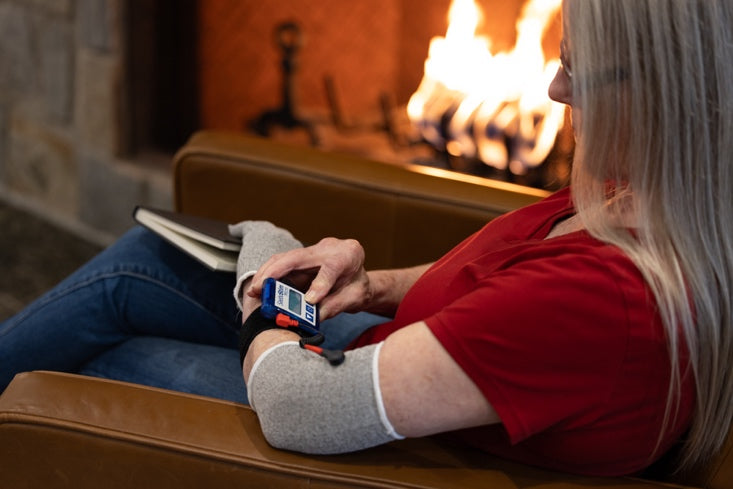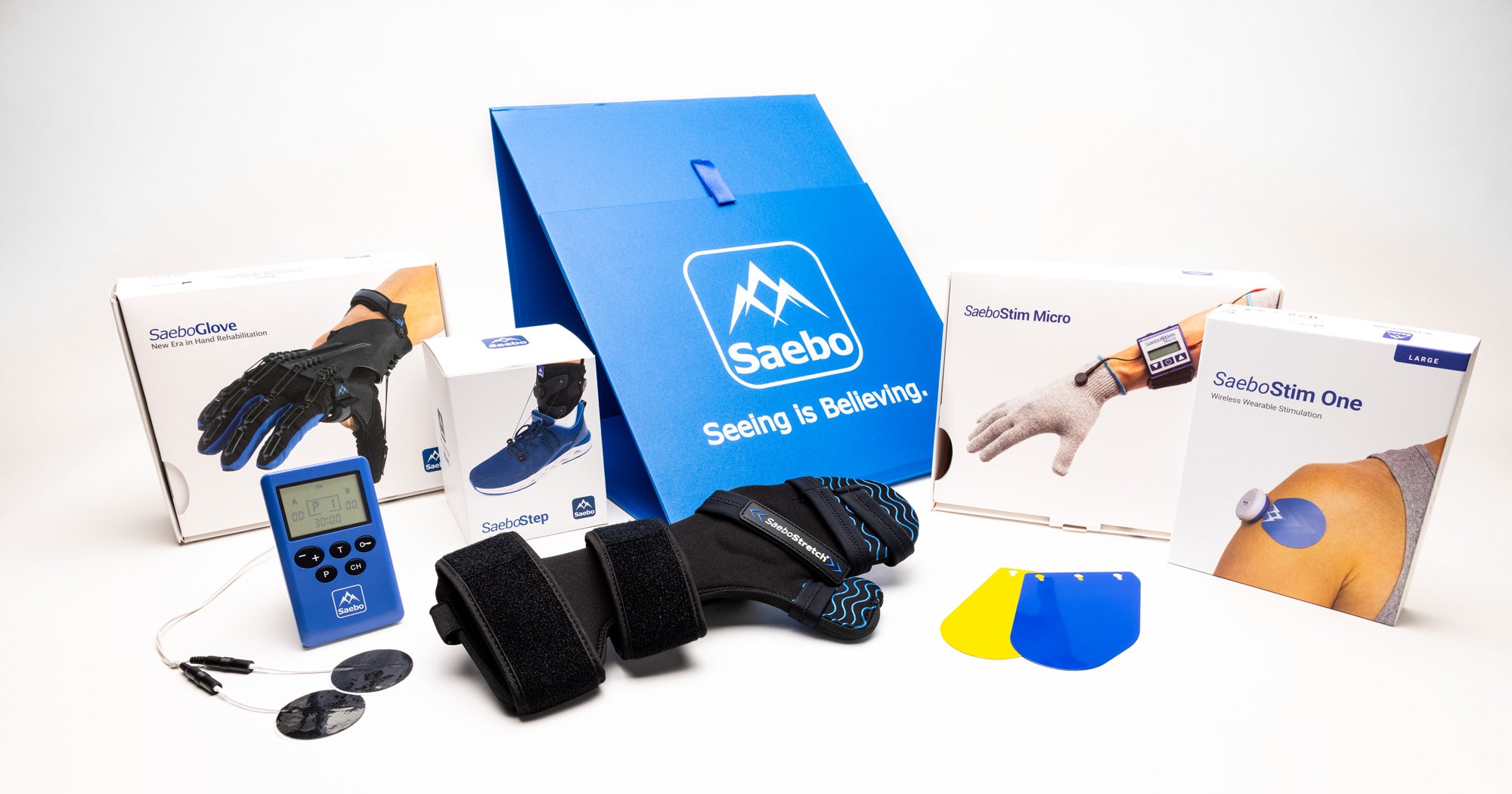Which Saebo Device is Right for Me? Your Complete Product Guide

From early stroke recovery to long-term neuro rehab, having the right support can shape your progress. Saebo’s devices are post-stroke rehab devices designed to empower you along the way, whether you’re working on regaining hand function, improving mobility, or building confidence in daily activities. In this article, we will delve into the primary challenges individuals face post stroke and discuss which of Saebo’s tools and tools will be the most impactful for individual’s needs.
In addition to individual devices, we will also discuss how different products work together to create detailed restoration solutions. From gravity minimizing arm supports to mental practice exercises, Saebo offers a wide range of tools to maximize the effectiveness of neuroplasticity and meaningful improvement post stroke.
This article will help guide you to the perfect Saebo product combination that matches your needs. This applies whether you're bouncing back from a stroke, dealing with spasticity, or working on sensory improvement.
Hand and Finger Weakness after Stroke
Stroke survivors often struggle with weak hands and limited finger movement in their daily lives. The brain can create new neural connections through rehabilitation tools that support the completion of neuroplasticity exercises and allow high levels of repetition in daily tasks. Saebo offers two primary hand rehabilitation devices that help with different recovery needs: the SaeboGlove and SaeboFlex.
SaeboGlove vs. SaeboFlex: Which One to Choose?
These products differ mainly in their design and target users. The SaeboGlove is a light, low profile fabric glove that uses elastic tensioning system to help your fingers and thumb extend after you grasp something. The spiral design of the orthotic portion wraps around your forearm keeps your wrist neutral and supports finger extension.
The SaeboFlex takes a different approach with its rigid outrigger system that covers your hand's back, fingertips, and forearm. This spring-loaded system helps your fingers extend after you grasp objects at a much higher level than the of the Glove.
Your level of muscle tightness (spasticity) determines which device works best for you. The SaeboGlove works great if you have little to no spasticity or contractures in your hand. People with low tone, flaccidity, or general weakness see excellent results with this device. Many users can pick up and release objects on their first try with the SaeboGlove further allowing them to complete meaningful repetitions in recovery.
The SaeboFlex might be your best choice if you have moderate to severe tone or spasticity in your hand and fingers. Its sturdy design and spring-loaded system give you more support to overcome tight, stiff muscles. An additional elbow support is offered that can combine with the hand/finger support of the Flex to develop what we call the SaeboReach.
While the SaeboGlove and SaeboFlex differ in design and level of support, both share the same purpose: enabling more practice, more function, and more progress in recovery. The best device is the one that meets you where you are today.
Helpful Tip: If your hand is very weak or flaccid with very little spasticity, the Glove may be best for you. If your hand gets very tight and is difficult to stretch out, then the Flex or Reach may be the more appropriate option.
How to Use Hand Supports for Daily Hand Exercises
These devices help with essential "grasp and release" movements that rebuild your brain's connections through cortical plasticity. This practice also reduces the negative effects of neglect. While the SaeboFlex does come with a more formal rehabilitation protocol, the Glove is best when used during daily activities.
Real-world exercises work well with the Glove:
- Pick up coins and put them in containers
- Fold and stack towels
- Button and unbutton shirts
- Open and close jars
- Use utensils to scoop or move objects
Regular practice prevents your arm from getting weaker after stroke and speeds up rehabilitation. By completing daily, repetitive activities, you are actively rewiring your brain and building new neural pathways that support long-term functional progressions.
Shoulder Pain and Subluxation After Stroke
Shoulder subluxation affects up to 81% of CVA survivors and causes partial dislocation of the shoulder joint [1]. The condition becomes painful when weak muscles let gravity pull the humerus bone away from the shoulder socket. This often leads to chronic pain and limited arm function.
Understanding Saebo Mobile Arm Support Gravity
The SaeboMAS works as a zero-gravity support system that helps weakened shoulders and is a good option for shoulder subluxation rehab. This dynamic device works better than traditional slings because it counteracts gravity's effects while helping functional movement. The system reduces training load by "unweighting" the arm, which helps motor recovery through normal movement pattern relearning.
Saebo Mini vs. Saebo MAS: Key Differences
The SaeboMAS Clinic model comes with a larger frame and mobile base. This makes it perfect for clinical settings where patients need support while sitting, standing, or lying down. The SaeboMAS Mini fits better at home since it mounts on tables and works well in small spaces. Though compact, the mini gives you the same zero-gravity benefits. Patients notice right away that their arm feels lighter and moves with better control making these devices great upper extremity rehabilitation tools for upper limb progress after a neurological injury.
Recommended Saebo Mobile Arm Support Exercises
Daily activities like eating, drinking, and self-care make excellent rehabilitation exercises. These movements help recovery when you repeat them with minimal compensation. You can exercise in multiple directions because the height of the MAS adjusts, which maximizes neuroplasticity through varied movements.
Stimulation Devices for Shoulder Subluxation
In addition to devices like the MAS, electrical stimulation therapy for post-stroke can helps treat shoulder subluxation effectively. These devices strengthen your shoulder joint muscles, especially the deltoid, which is a great proximal migrator of the humerus to help stabilize the joint. Regular use reduces subluxation symptoms and pain substantially.
SaeboStim One vs. SaeboStim Pro
The SaeboStim One's wireless design makes shoulder subluxation treatment easier. This is a small, wearable device with no lead wires that allows you to wear it while you’re completing your regular activities. It cycles itself in hour long periods allowing you to carry on your day without having to manage the device.
The SaeboStim Pro features two channels and a trigger button that help you practice functional tasks. Like the Stim One, the Pro also aids in shoulder subluxation by strengthening muscles surrounding the shoulder, but with the added benefit of the trigger function.
The Stim One is an ideal choice for home rehab for stroke due to its simple design, whereas the Stim Pro is a great in-clinic tool due to the varying treatment options.
Spasticity: Managing Muscle Tightness
Spasticity remains one of the toughest complications after a stroke. Nearly 38% of patients experience this condition in their first year [2]. Muscle tightness can make daily tasks difficult and cause pain without proper treatment. Several Saebo devices tackle this symptom through different methods.
SaeboStretch for Spasticity: When and How to Use
The SaeboStretch is a fantastic spasticity management tool that works as a dynamic resting finger extension splint that helps people with spastic muscles. Unlike other rigid splints, the Stretch’s flexible finger plate provides gentle, extended stretching while letting your digits move naturally with spasms or fluctuating abnormal tone. You won't experience painful stretching, but your hand stays in the right position making this an ideal resting hand brace for neurologic injury progressions. SaeboStim Pro vs. Micro vs. One: Which Estim Device Fits?
Electrical stimulation helps fight spasticity effectively. The SaeboStim family comes in three versions:
- SaeboStim Micro: This wearable, low-level electrical stimulation device works below threshold levels. It is designed to improve sensation and reduce spasticity.
- SaeboStim Pro: A dual-channel device with programmable settings reduces spasticity and strengthens weak opposing muscles. Its trigger button makes task-specific training easy.
- SaeboStim One: It’s a single-channel wireless device for targeted muscle stimulation, often used to improve strength, function, and reduce spasticity in specific muscle groups.
The SaeboStim Micro is often better for spasticity than the One or Pro because its gentle, sensory-level stimulation calms overactive muscles and retrains the nervous system without forcing contractions, making it ideal for reducing tone and preparing the arm for movement. In contrast, the One and Pro focus on muscle strengthening and task-specific training rather.
Cognitive and Motor Planning Challenges
Stroke survivors face cognitive challenges alongside physical limitations that make return to normalcy a complex experience. The brain's knowing how to organize and execute movements often becomes impaired. This requires specialized rehabilitation approaches.
What Is SaeboMind and How It Helps
SaeboMind offers an innovative audio collection of guided mental practice exercises designed specifically for neurological rehabilitation. This approach employs imagination to activate the same neural pathways used during physical movement. Studies confirm that mental rehearsal of specific tasks triggers the brain's motor, sensory, and perception centers similar to physical activities [3].
Mirror Therapy for Stroke
The Saebo Mirror Box takes a different but complementary approach to rebuilding neural connections. This simple device creates a powerful visual illusion that helps your brain see the affected limb as healthy. By reflecting the movement of your unaffected limb, the mirror tricks your mind into perceiving both limbs as functioning normally. Regular use can help strengthen neural pathways, improve motor control, and support overall recovery.
Combining Mental Practice with Therapy
Mental practice delivers the best results when combined smoothly with physical or occupational therapy rather than used alone. Using both approaches together produces better outcomes for upper and lower limb function compared to physical practice alone.
SaeboMind, a great mental practice rehabilitation tool and the SaeboMirror Box work well with other Saebo devices. To name just one example, see how practicing SaeboMind exercises before using your SaeboGlove or SaeboMAS can prepare you mentally for the physical task and potentially improve overall performance. Research has also shown that combining mental practice with electrical stimulation creates substantial improvements in upper extremity impairment, dexterity, and participation in valued activities [4].
Sensory Loss and Recovery
Patients with sensory impairments face unique rehabilitation challenges alongside motor deficits after neurological injury. These problems show up as reduced sensation, numbness, tingling, or not being able to tell temperatures and textures apart. Your upper extremity need all these abilities to function safely.
SaeboStim Micro
The SaeboStim Micro sets itself apart as a specialized sensory electrical stimulation device that tackles these sensory deficits head-on. This compact, wireless unit works differently from other Saebo electrical stimulation devices. It sends gentle electrical currents at levels so low you won't feel your muscles contract - just subtle sensations that help retrain your nervous system.
The device's power lies in its ability to work on both motor and sensory nerves at the same time. You don't need to worry about settings - it comes ready to use with pre-programmed parameters that support neurological recovery.
Best Practices for Sensory Recovery
Electrical stimulation helps, but you should also try tactile discrimination exercises. These simple activities involve touching and identifying objects without looking or feeling different textures with your affected hand.
Your recovery works better when you watch your arm while doing these exercises. Seeing your hand touch different textures helps your brain connect visual and touch signals more effectively. Your sensory recovery needs a complete approach. Keep objects with different textures nearby and explore them throughout your day. Regular practice helps your brain rebuild connections, which might speed up your recovery.
Multi-Symptom Recovery and Full Arm Rehab
Combining Saebo Products for Complex Needs
Multiple symptoms require integrated approaches instead of single solutions. Mechanical support combined with electrical stimulation creates new recovery possibilities, even for limbs that don't work at all. This blend lets clients use their hands right from the start of recovery, which might eliminate their need for assistive devices later.
How SaeboGlove and SaeboStim Work Together
Stroke patients who couldn't use their upper limb have shown to improve when they used the SaeboGlove with electrical stimulation. The electrodes go on the muscles that close the fingers, and the SaeboGlove fits over them. Stimulation helps with gripping while tensioners help with opening. The SaeboStim Pro's trigger button gives complete control - press it to close your digits around objects and release it to let the tensioners open your fingers.
Combining Saebo MAS with Daily Tasks
SaeboMAS opens up new ways to practice everyday activities. It supports the arm's weight and makes previously impossible tasks like eating, computer work, and grooming possible. This zero-gravity support lets you practice longer with fewer breaks because you won't get tired as quickly meaning you can increase the number of repetitions completed furthering the effect of neuroplasticity.
Key Takeaways
Choosing the right Saebo device depends on your specific symptoms and recovery needs, not a one-size-fits-all approach.
• SaeboGlove works best for minimal spasticity; SaeboFlex handles moderate to severe muscle tightness - Your level of muscle tone determines which hand device will be most effective for recovery.
• SaeboMAS provides zero-gravity arm support, making previously impossible daily tasks achievable - This mobile arm support counteracts gravity effects, enabling functional movement even with significant weakness.
• Combining tools amplifies results - patients with no hand function have improved using SaeboGlove plus electrical stimulation - Integrated approaches create recovery opportunities that single devices cannot achieve alone.
• Consistency trumps intensity - regular daily practice with proper device selection drives neuroplasticity and lasting recovery - Dedicated routine use prevents further weakness and promotes faster functional improvement.
• SaeboStim devices target different needs: Pro for dual-channel muscle strengthening with trigger function, SaeboStim Micro for sensory recovery, SaeboStim One for targeted muscle strengthening - Match your stimulation device to your primary symptom for optimal therapeutic benefit.
The key to successful rehabilitation lies in understanding your specific symptoms and selecting the appropriate Saebo device combination, then maintaining consistent daily practice to maximize neuroplasticity and functional recovery. By combining different devices and treatment options, all individuals post-stroke can experience improvement in their abilities. To further explore the full range of solutions offered by Saebo and to use their Product Selector tool, check out their website here.
References
All content provided on this blog is for informational purposes only and is not intended to be a substitute for professional medical advice, diagnosis, or treatment. Always seek the advice of your physician or other qualified health providers with any questions you may have regarding a medical condition. If you think you may have a medical emergency, call your doctor or 911 immediately. Reliance on any information provided by the Saebo website is solely at your own risk.



